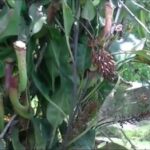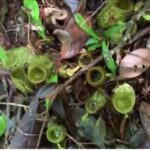As an Amazon Associate, this site earns commissions from qualifying purchases. For more details, click here.
Native to the Philippines, Nepenthes ventricosa is among the easiest pitcher plants to grow. It is very forgiving so it is perfect for a beginner. A mature n. ventricosa can reach 8 inches and comes in various shades of red, green, pink and white. If you want to try your hand at raising nepenthes, this is a good choice.
Nepenthes ventricosa grows in indirect light indoors or outdoors. Use sphagnum moss or peat for the soil and keep the plant in temperatures above 55 F (12.7 C). Nepenthes ventricosa does not go dormant and cannot survive frost.
Nepenthes Ventricosa Care Sheet
| Soil | Long fiber sphagnum moss and pumice, moist soil |
| Water | Reverse osmosis, spring, distilled, purified, rainwater |
| Light | 6-8 hours bright, indirect light, grow lights will work |
| Food | Fish flakes,, pellets, small insects, freeze dried mealworms |
| Temperature | 55-85 F (12.7 38 C) |
| Humidity | 50%, but will live in lower humidity |
| Dormancy | No |
| Propagation | Stem cuttings |
Soil
Nepenthes ventricosa should be planted in long fiber sphagnum moss and pumice. Use only low nutrient, porous media like perlite, peat, fir bark and tree fern fiber. The soil should always be moist but not too soggy.
If you prefer a simpler approach, buy ready made soil with your pitcher plant. Most nepenthes sold online include the potting media and container so you can raise the plant immediately. We prefer Doter Sphagnum Moss Potting Mix as it is the type of media that n. ventricosa thrives in.
Potting mixes are usually 50/50, for example peat moss and perlite equally. You can adjust the ratio for better growth but if1:1 works there is no need to change it up. If you have cultivated n. ventricosa before, you can adjust the soil mixes incrementally.
The soil is one of the keys to keeping pitcher plants alive. Use low nutrition media and never fertilize it. Since carnivorous plants get their nutrients from insects, there is no need to fertilize with rich soil.
Pot Container
Most pitcher plants grow in 3-5 inch pots including n. ventricosa. The pitcher size ranges from 4 to 9 inches but a small to medium sized pot will be enough. Repot the plant if it grows larger than expected.
If you have to repot nepenthes, do it in the spring before any new growth appears. Turn the pot upside down and hold the plant with one hand. Shake the pot to remove the soil. Examine the root for signs of rot or other infection. Trim any infected parts and plant only the healthy remnants.
Water the plant right after repotting. Moving n. ventricosa to a new home might produce shock, but watering makes the adjustment easier.
You can use any plant container for n. ventricosa except clay as they are prone to mineral buildup. Plastic is a low cost and effective solution.
Water
Nepenthes ventricosa should be watered from the top to keep the soil moist but not too damp. You can mist the leaves during dry, hot days. The tray method should be used sparingly or not at all.
Purified or natural rainwater is best for n. ventricosa .Unlike other nepenthes, this species is more forgiving with tap water. You should avoid this type of water if possible. But low chlorine tap water does not seem to harm the plant provided it gets plenty of light.
Water the plant from the top with a spray bottle. Repeat when the soil starts to dry. If it is very hot and dry, mist the leaves lightly. This helps increase moisture and water retention in the soil.
The tray method is widely used with Venus flytraps and sundews. You can also use it with sarracenia pitcher plants. With nepenthes however you need to be careful.
Nepenthes ventricosa should not sit in water for prolonged periods. Water only from the top and mist the leaves instead. If you want to use the tray method, do it sparingly and only if the soil dries too fast.
The tray method is very popular among growers because it is convenient. However, n. ventricosa roots are prone to overwatering. Too much standing water could damage the roots and destroy the plant.
If you want to sit nepenthes in water, use only 0.5 to 1 inch of water. As soon as the temperature drops and humidity rises, remove the tray and go back to overhead watering.
Light
Bright, indirect sunlight is the best for these plants. You can grow n. ventricosa indoors on a south facing window or have it partially shaded outdoors. You can also use grow lights.
Indoors. N. ventricosa is ideal as an indoor plant. Since it cannot handle winter freezing chances are you will be growing this plant inside anyway. It adapts well to a greenhouse, terrarium or a windowsill pot.
Morning sunlight is perfect for indoor nepenthes. If it is a south facing window, partially shade the plant at midday to protect it from intense heat.
Artificial lights. A nice choice for n. ventricosa are the GE Grow LED Light Bulbs. Position it about 12 inches away and keep it on for several hours a day. Use grow lights during winter or any occasion when natural light is limited.
Outdoors. Nepenthes needs sunlight but too much can be harmful. To be safe, place the plant in a partially shaded area. Even a little bit of foliage covering the plant will be enough. As long as it is indirect sunlight your nepenthes will thrive. For more about growing pitcher plants indoors or outdoors, here is a guide.
Temperature
Nepenthes ventricosa is one of the most adaptable when it comes to temperature swings. As long as it is nowhere near freezing or above 100 F (38 C) this plant will survive. The maximum range is 55-85 F (12.7 38 C).
Of course we want n. ventricosa to thrive, not just live. To do this, the daytime temperature should be in the 70s (21-28 C) and at night 50-60 F (10-16 C). If you are cultivating indoors you have a greater control over this.
Not that n. ventricosa is more resilient to heat and cold compared to other pitcher plants. Some nepenthes in the wild are exposed to 90 F or higher and do not wither. If you have a healthy plant it might be able to survive higher heat levels, but it is best to grow the plant under 85 F.
Humidity
Low to mid humidity is enough for nepenthes ventricosa. As long as the soil is most and the weather is mild, humidity will not be a problem.
You can use a humidifier if the level goes too low or too high. Most nepenthes prefer a humidity level of at least 50%. N. ventricosa benefits from medium to high but it does not seem to suffer when it is low.
Humidity is important in terms of keeping soil moist. It also helps pitcher plants produce more liquids for their traps. However you should focus more on getting the light, water and temperature levels right. If you do the humidity should be sufficient.
Nutrition and Feeding
If your nepenthes is outdoors and hanging, insects will be attracted to it. Do not provide fish food, worms or any other nutrients. There is more than enough prey to keep the plant full.
You should only feed carnivorous plants if they cannot catch prey. If your n. ventricosa is in a terrarium for example, feed every week or every two weeks. Drop the food in one of its pitchers, not all of them.
Nepenthes eats live and dead bugs, fish beta pellets and dried worms. Do not overfeed it. At most you may feed 2-3 pitchers, but even one is enough. Increase food intake if your plant looks weak and lacks vitality.
Dormancy
Nepenthes ventricosa does not have a dormancy phase. Plant growth may slow in winter but it will continue. It cannot survive freezing or below freezing temperature.
If there is winter in your region, grow this plant indoors. Or you can leave it outdoors during spring and summer but take it inside when the temperature drops. Keep the plant in a warm location inside your home. Use indoor grow lights if sunlight is limited.
Once winter ends, growth will speed up and you can resume normal watering. You can propagate or repot nepenthes just before any new growth springs up.

My fascination with carnivorous plants began many, many years ago with Venus Fly Traps. Now I am more than happy to impart what I know with other enthusiasts and those who are curious about meat eating plants.



